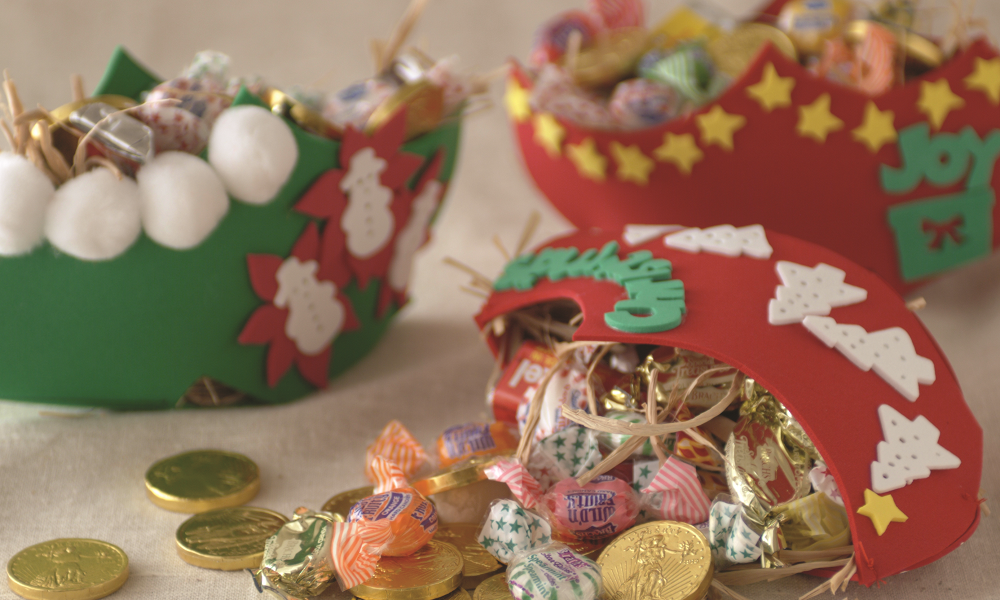
Shoes for St. Nick
This children’s craft reminds us all of the saint behind Santa Claus
This children’s craft reminds us all of the saint behind Santa Claus
It’s easy amid the commercialization of the Christmas season to forget that Santa Claus has his origins in a third-century bishop of our faith named St. Nicholas.
According to a website devoted to this venerated man www.stnicholascenter.org, St. Nicholas was born in 271 A.D. in Patara, a village in Turkey. His wealthy parents, who raised him to be a devout Christian, died in an epidemic while Nicholas was still young. Obeying Jesus’ words to “sell what you own and give the money to the poor,” Nicholas used his entire inheritance to assist the needy, the sick, and the suffering. He dedicated his life to serving God when he entered a monastery and, later, became its abbot. In recognition of his devout nature, he was made Bishop of Myra while still a very young man.
Under the Roman emperor Diocletian, Bishop Nicholas suffered for his faith and was exiled and imprisoned. After his release, he participated in the Council of Nicaea in 325. He is thought to have died around December 6, 343 in Myra and was buried in his cathedral church, where a unique relic of sorts – called manna – formed in his grave. This liquid substance was said to have healing powers and helped foster the growth of devotion to Nicholas. The anniversary of his death later became a day of celebration – St. Nicholas Day.
Over the years, many legends have risen up around St. Nicholas. One of these involves a poor father who had no money to apply to dowries for his three daughters, who were then in danger of being sold into slavery. Hearing of the family’s plight, St. Nicholas was said to have anonymously tossed a bag of gold through an open window in their home. The bag landed in stockings or shoes left to dry by a fire. This led to the custom of children hanging stockings or putting out shoes in anticipation of gifts from St. Nicholas.
This is a particularly strong tradition in the Netherlands, where children leave wooden shoes filled with carrots and hay outside their door on St. Nicholas’ eve. The unusual stuffing is meant to feed St. Nicholas’ steed, a white horse. If the child who owns the shoes has been good, he or she is rewarded with candies such as chocolate coins, which harken back to the legend of the three daughters. Cookies in the shape of alphabet letters, fruits, and small gifts may also be left inside the shoes.
To celebrate St. Nicholas’ feast in the traditional way, why not encourage your children to switch from a Christmas stocking to a shoe this year? For young children, creating a ‘wooden’ shoe out of felt or foam can be an easy-to-assemble craft project.
To start, draw and cut out for them a three-part outline of a wooden shoe: two mirror-image sides and a base. A length of seven or eight inches is a good size.
Tack the pieces together with thread or yarn; joined together, they should form an upright shoe that bulges a bit in the middle.
Have your kids decorate the shoe with paints, glitter, foam pieces, bells, ribbons, beads, etc. And advise them to set it out on December 5 in anticipation of St. Nicholas’ arrival.
Your final job is to fill it with chocolate coins, cookies, fruit, nuts, or small toys.
When they come out of their bedrooms on the morning of St. Nicholas’ day, you can read them “The Story of Saint Nicholas,” written by Victor Hoagland, C.P.
Enduring Dutch Christmas Customs
Other Dutch traditions that have influenced our celebration of Christmas may be found in Santa’s outfit (a red garment), his appearance (a long white beard), and the concept of a Santa helper. In the Netherlands, Sinterklass is accompanied by a fellow named Zwarte Piet (Black Pete) who assists him in his rounds and sometimes disciplines those children who are found a little wanting.
The Many Churches of St. Nicholas
As the St. Nicholas Center website notes, its namesake is so widely revered that 2,000 churches have been named after him worldwide. In Michigan, those structures include St. Nicholas Antiochian Orthodox Church (Grand Rapids), St. Nicholas Byzantine Catholic Church (Detroit), St. Nicholas Greek Orthodox Churches (Ann Arbor and Troy), St. Nicholas Orthodox Church (Burton), and St. Nicholas Roman Catholic Church (Cross Village).



